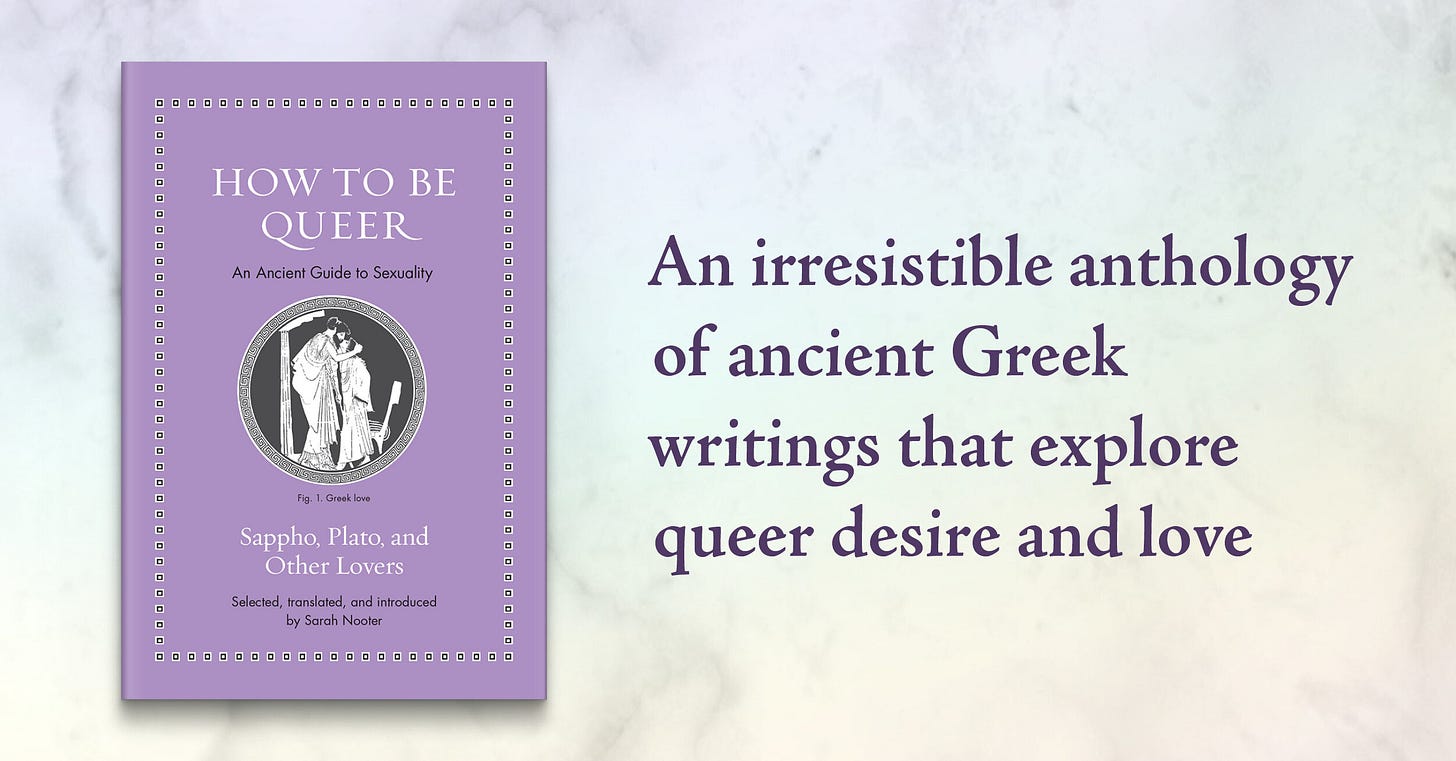
This week, we celebrate Pride Month 🏳️🌈🏳️⚧️.1 First, T.H.M. Gellar-Goad discusses his new, open access book on the global power of masks from antiquity to today. Then, Emily Wilson writes about Anne Carson and Sappho, a new book on ancient sexuality looks at How to Be Queer, the queer past of Old Delhi, new publications on queering the Bible and trans identity in Jewish apocryphal books, some enchanting ancient same sex love spells, a groundbreaking website focused on Asian and Asian American classical reception, new ancient world journals, and much more.
Revealing the Global Power of Masks by T.H.M. Gellar-Goad
Last week, the Republican-controlled North Carolina state legislature passed a bill to modify the public-health exemption previously appended to the state’s masking law.2 Known as the “Unmasking Mobs and Criminals Act, HB 237,” the loophole they wish to close was added to the state's anti-masking legislation in 2020. The original version of the legislation eliminated the public-health exemption, which would have made it illegal for immunocompromised people to protect themselves by wearing masks in public places. After debate, the current bill replaced the pandemic-era wording allowing masks worn for “the physical health or safety of the wearer or others,” with a more narrow allowance that permits “medical and surgical grade” masks used for “preventing the spread of contagious disease.”
You might not realize it, but it's already illegal to wear a mask in public in North Carolina and eleven other U.S. states, D.C., and at least 12 other countries. The original law in North Carolina dates to 1953. But it has exceptions: seasonal holidays, theatrical productions (including Mardi Gras and masquerade balls), work, government-registered secret societies, and health and safety reasons. Democratic Governor Roy Cooper is expected to veto the current bill. However, it is unclear whether Republicans—who have gerrymandered themselves a veto-proof majority in both chambers—will manage to override it. If they do, there will soon be escalated punishments in North Carolina for actions such as wearing a COVID mask while blocking traffic as part of a protest.
What were the real reasons behind the removal of the public health exemptions?Advocates for the bill are directly reacting to student protesters on university campuses who have used COVID masks not only to avoid contagion but also to shield their identity from police surveillance.3 The state legislature's action on masks is just the latest front in an ongoing culture war over masks, one that extends back way farther than the maskers and anti-maskers of the early COVID era. Why, after all, is public masking illegal?

Masks have power. As I discuss in my recently published book Masks—available for free download here, and from which I excerpt in the following paragraphs—masks do important cultural work for us, across time and the globe, in six key domains: theater both literal and metaphorical, religion and ritual, memorialization, transformations big and small, reflection on oneself and society, and, yes, medicine.
In recent pre-pandemic memory, Guy Fawkes masks appeared everywhere in pro-democracy protests as part of the Arab Spring and the Occupy Wall Street movement. They led to bans of those particular masks in Bahrain and the United Arab Emirates. The original North Carolina anti-masking law was passed in the 1950s, specifically to combat the influence of the Ku Klux Klan. The government hoped that, if secret societies were required to register in order to wear masks in public, it would be easier for law enforcement to track KKK membership and reduce the Klan's racist terrorism.

The ability of a mask to conceal one’s identity makes it an obvious choice for a secret society like the KKK. The symbolism and drama of a mask don’t hurt, either. The English words “mystery” and “mystical” ultimately derive from the ancient Greek phenomenon of mystery rites, secret religious practices that were open only to those undergoing a special initiation. For example, the lesser-known mystery cult of Despoina (daughter of Demeter and Poseidon) in Lycosura, a city in Arcadia, southern Greece, seems to have involved not only initiation but also an ecstatic ritual dance performed by priests wearing animal masks.
The magic of the mask in a secret society fulfills two diametrically opposed purposes. On the one hand, it anonymizes. By covering the face of the individual, it erodes their individual identity. This function can be particularly important when masks are used to navigate sanctioned violence. Take the archetypal executioner’s mask, which conceals (protects? erases?) the identity of the state’s chosen killer. That mask is a device not only personal but also societal, the trappings of a ritual of the state. Among certain Indigenous groups (such as the Moche, Calima/Calima-Malagana, Salinar, Muisca/Nariño, Jama-Coaque, Vicús, Chimú, Tairona, and Quimbaya) in Colombia, authority figures might wear a nariguera—a mask attached at the nose that covers the mouth—when issuing judgments or when performing rituals of death and of war.

On the other hand, the mask identifies. Wearing a mask is a conspicuous act, and secret societies tend to ensure that their masks are readily identifiable even (or especially) to non-members. Think again of the distinctiveness of the masked executioner or the authority figure wearing a nariguera, both of whom are marked as performing a special social duty. When worn in numbers, like Guy Fawkes masks or Klan hoods, the mask subsumes the identity of the one to the identity of the many. It visually suggests a group ego, a hive mind of solidarity or conformity. It projects communal values, and tells its wearers that they are part of something greater than themselves.
Things are different today with the development of facial-recognition technology, a massive leap in the capacity for state surveillance. Our faces, caught on screen and processed by algorithms, have themselves become a kind of mask, one that doesn’t conceal who we are but broadcasts our identity to anyone with the right app.
Nowadays, peaceful protesters and violent agitators alike are likely to fall back on masks as a last line of defense of their privacy and personhood. Even more so in the aftermath of the Capitol Insurrection, where a combination of facial recognition and old-fashioned sleuthing of photographs and video captures has led to the arrest and conviction of numerous lawbreakers and traitors.
Wearing a mask grants anonymity to the individual. At the same time, wearing a mask can paradoxically disclose an identity. The hood marks the Klan member; the Guy Fawkes mask marks the Arab Spring or austerity protester. Governments allegedly want neither of these things: no anonymity and no group solidarity, whether the group is a hate group or a protest.
Strange, then, that in an early round of debate on their proposed removal of the public-health exemption for masking, North Carolina Republicans voted down a proposed amendment to the bill made by Sen. Jay Chaudhuri to ban hate groups like the KKK and the Proud Boys from wearing masks in public. As WRAL noted, “Republican lawmakers shot it down with no debate or explanation.”
Sometimes, the mask does fall.

Queer Public Humanities and a Queer Global Antiquity
If you’ve been reading us for a while, you won’t be surprised to see us plug Emily Wilson’s newest words in The Nation: Anne Carson. Myth. Sappho shout-outs. You’d better be clicking already.
It was during her adolescent Wilde phase that Carson experienced her magic spider bite, the moment she was infected with her superpower: She discovered, in a shopping mall in Ontario, a copy of Sappho’s poetry (in the old Willis Barnstone translation, with the Greek original facing). As she later said in an interview, “I thought, ‘Well, if I learn Greek, I could be all the more like Oscar Wilde.’… It seemed like the natural next step.”
Also check out Liv Yarrow’s teaching units on Sappho and non-binary bodies before delving into the Toast’s (RIP!) amazing post on “Paintings Of Sappho In Order Of How Bummed Out She Looks.” Lots of resting sorrow face in these depictions—and big thanks to Amy Pistone for reminding us to reread it. Finally, if you are already a Toast fan, you will love Daniel Lavery’s imagined discussion between two Romans sculpting “The Dying Gaul.”
Greek drama and ancient reception specialist Sarah Nooter’s new book, How to Be Queer: An Ancient Guide to Sexuality (Princeton University Press, 2024), just came out on June 4. The anthology provides a great sampling of readings from various ancient authors, among them Sappho, Plato, Homer, and many more.
You already knew that Old Delhi was stuffed to the gills with centuries of history, but what about its queer past? Tour guide Iqbal Ali, a trans nonbinary Muslim, leads visitors on queer heritage walks around the city center. Highlights include Sunehri Masjid (the Golden Mosque) and the tomb of India’s first education minister. (Their Instagram grid, by the way, is full of amazing photos and videos.)
Boyfriends fighting? Certainly not during Pride, but definitely in ancient Greece. In the Post, Ainsley Hawthorn reminds us of the power of love and the history behind the Sacred Band of Thebes. Note that a few years ago, the New Yorker commissioned a great drawing (see below) of the 254 warriors discovered in Chaeronea that had been buried with linked arms, as an illustration for the Theban Sacred Band article written by Daniel Mendelsohn.
The Thebans couldn’t compete with that scale of military training, so a commander named Gorgidas suggested that they deploy a uniquely Theban strength against their enemies: male erotic love.
If you want to delve more into biblical studies and queerness, Melissa Harl Sellew has a number of important articles to engage with. Check out “Galatians” (with Joshua Reno) in the second edition of The Queer Bible Commentary, as well as articles on “Reading the Gospel of Thomas from Here: A Trans-Centered Hermeneutic” and “Traversing the Society of Biblical Literature while Trans.” Over at ancient religion scholar Jaeda Calaway’s personal blog, she looks at the trans experience through the lens of the late antique text called the Sepher Hekhalot ("Book of Palaces," also known as 3 Enoch).
Also, you can now preorder Taylor Petrey’s new book, Queering Kinship in the Mormon Cosmos, out with UNC Press in October. Father Jarel Robinson-Brown, Vicar of St German's Church (Adamsdown, Cardiff) also announced that his new book, The Rest is Darkness: A short history of early Christianity in Africa, will be out in 2025. Finally, you can explore the digital pages of Embodied: The Stanford Undergraduate Journal of Feminist, Gender, and Sexuality Studies to read Carolyn Ky’s engaging article on asceticism and trans saints, “Divine Drag: Unveiling Ascetic Afflictions through Hierarchy, Race, and Queerness.”

Ancient historian Evan Jewell hipped us to a great post at Jenny Cromwell’s Papyrus Stories on “Ancient Same Sex Love Spells,” that has lots of epigraphic and papyrological evidence for same sex love, desire, and magic. Many of the late antique spells are also discussed in Bernadette Brooten’s epic must-read: Love Between Women: Early Christian Responses to Female Homoeroticism, which you can read for free at the Internet Archive.

At UCLA, Prof. Kelly Nguyen led a groundbreaking (seriously, first of its kind) course called Asian and Asian American Classical Reception. Check out her students’ amazing final projects and Nguyen’s killer syllabus, along with this very cool Instagram account that they created:
History professor, Director of Africana Studies at USD, and Jeopardy champion T.J. Tallie was on the BFF: Black, Fat, Femme pod discussing being a minoritized person in academia—and whether to go ahead and get that MA or PhD (in this economy?).
Historian of modern Germany, Bavarian, and professor of mixology Philipp Stelzel— author of the new book, The Faculty Lounge: A Cocktail Guide for Academics—has a great cocktail recipe for those who wish to raise a glass this month. It is called “The Gin-der as Performance” (a Judith Butler Cocktail). Bibe multis annis!

New Antiquity Journal Issues (by @YaleClassicsLib / yaleclassicslib.bsky.social)
Historia Vol. 73, No. 3 (2024)
Zeitschrift für Assyriologie und Vorderasiatische Archäologie Vol. 114, No. 1 (2024)
Cahiers des études anciennes Vol. 61 (2024) #openaccess Dialogue et enseignement
Zeitschrift für Ägyptische Sprache und Altertumskunde Vol. 151, No. 1 (2024)
American Journal of Archaeology Vol. 128, No. 3 (2024)
Gallia Vol. 80, No. 2 (2023) #openaccess
Journal for the History of Rhetoric Vol. 27, No. 1 (2024) Archimedean Levers and Rhetoric’s Common Grounds: Articles in Honor of James J. Murphy
Numen Vol. 71, No. 4 (2024) NB : Jesper Høgenhaven, et al., “A Neurocognitive Model for Analyzing End Time Narratives: the Book of Revelation 14–16 as a Test Case”
History of Philosophy & Logical Analysis Vol. 27, No. 1 (2024)
Vox Patrum Vol. 90 (2024) #openaccess Reception History of Galatians 6:17 among Patristic Writers
Annuaire de l'EPHE, section des Sciences historiques et philologiques (2022-2023) Vol. 155 (2024) #openaccess
History of Philosophy Quarterly Vol. 41, No. 2 (2024)
Anales de Filología Clásica Vol. 2 No. 35 (2022) #openaccess
Rivista di Studi Fenici Vol. 51 (2023) #openaccess
Events, Lectures, and Exhibitions
On June 22, 2024, join via Zoom for “Pride, Rage and Prophecy: Transatlantic Reflections of a Black Queer Priest” with the Reverend Jarel Robinson-Brown. This transatlantic virtual event begins at 1 pm EDT in New York and 6 pm in London and Cardiff.
On June 25, 2024, there is an LSF Online Classics Lecture by Dr Joe Watson on “Having a Queer Old Time with Tibullus.” You can get online tickets here.
In art news, at the National Gallery of Victoria’s online exhibition space, they have a number of essays published in the now out-of-print QUEER: Stories from the NGV Collection. In one essay, curator Ted Gott explores queer histories of Greece and Rome. Also, there is a fab MOCA queer StoryJam in NYC tonight, and the Met has now updated their large “Index of LGBTQIA+ Artists.” The digital database builds on “library initiatives to raise the visibility of artists from marginalized communities in the Met Libraries, including the creation of the Index of Black Artists of North America, the Index of Asian American and Pacific Islander Artists, the Index of Indigenous and Native American Artists, and the Index of Latinx and Hispanic American Artists.” One of our favorites? Gabriel García Roman’s use of religious imagery, collage, and the aesthetics of Byzantine icons for his Queer Icons series.
The month of June was chosen in memory of the Stonewall Uprising of June 28, 1969 in Greenwich Village. Read more about it at the Library of Congress’ research guide.
A portion of this essay was previously published by T.H.M. Gellar-Goad for an op-ed for Chapelboro on June 14, 2024 titled “Public Masking.”
“The changes were originally proposed in the Senate last month as revisions to an existing House bill, to address what Republicans said were instances of people wearing masks to conceal their identity, sometimes at public protests, and in other cases while committing crimes,” Avi Bajpai, “What to know about new changes proposed to NC’s mask laws,” News & Observer (June 6, 2024).














